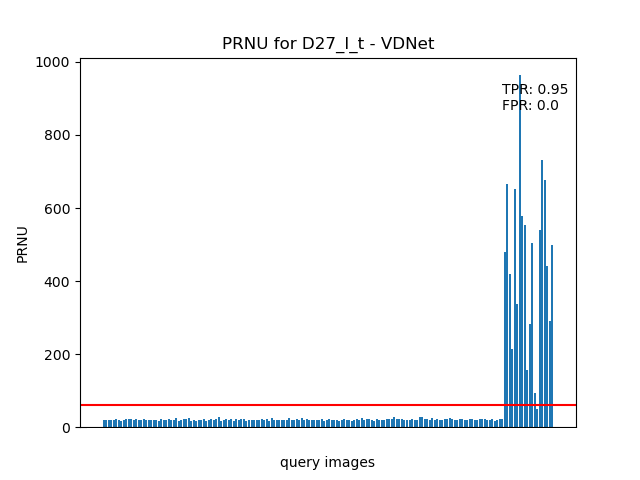This project is based on the work of [2], the goal is to extract camera sensor’s fingerprint from captured images and compare this reference to other query fingerprints in order to perform a camera identification task. We will use Photo-Response Non-Uniformity (PRNU) extracted from flat and not saturated images as a unique fingerprint of digital camera and use Peak-correlation-to-energy (PCE) for the identification task. There are several different algorithms to extract fingerprints. In this report we extend the implementation provided in [2] by adding 2 new noise extraction methods: VDNet[1] and VDID[3].
VDNet uses a variational inference for non-iid real-noise estimation and image denoising in a unique Bayesian Network. Specifically, an approximate posterior, parameterized by deep neural networks, is presented by taking the intrinsic clean image and noise variances as latent variables conditioned on the input noisy image.
Variational Deep Image Denoise (VDID) is a bayesian framework that can handle blind scenarios based on the variational approximation of objective functions separating the complicated problem into simpler ones. Its main characteristics are:
- It handles both AWGN and real-world noise
- Trained in an end-to-end scheme without any additional noise information
- Requires fewer parameters than state-of-the-art denoisers
The objective is formulated in terms of maximum a posterior (MAP) inference. An approximated form of the objective is calculated by introducing a latent variable based on variational Bayes which incorporates the underlying noisy image distribution. Based on the latent space, VDID can focus on simpler subdistributions of the original problem.
For the experiments we used the VISION dataset provided by LESC laboratory [4]. It contains about 30 devices and for each device there are flat and not saturated images from which the reference fingerprints are extracted. Each of them is then compared with 20 natural image query fingerprints from all other devices.
The respository is structured as follows:
example.pyis the script used to test and evaluate the PCE.- The
plots/directory contains bar plots for each device showing PRNU, TPR and FPR values. This folder is divided in 3 subdirectories, one for each denoiser. Each subdirectory has one bar plot for each device. prnu/contains the noise extraction functions (original, VDNet and VDID).test/will contain your dataset: flat images must be placed in theff/subdirectory and query images innat/subdirectory.
.
├── example.py
├── plots
│ ├── original
│ │ ├── D08_I_t_.png
│ │ ├── ...
│ ├── vdid
│ │ ├── D08_I_t_.png
│ │ ├── ...
│ └── vdnet
│ ├── D08_I_t_.png
│ ├── ...
├── prnu
│ ├── functions.py
│ ├── VDIR
│ │ └── ...
│ └── VDNet
│ └── ...
├── README.md
├── requirements.txt
└── test
├── data
│ ├── ff
│ │ ├── D08_I_t_0011.jpg
│ │ ├── ...
│ └── nat
│ ├── D08_I_t_0062.jpg
│ ├── ...
└── test_prnu.py
git clone https://github.com/sim-pez/PRNU
cd PRNU
pip3 install -r requirements.txt
Run example.py to evaluate the PCE
python3 example.py
Compute PCE
usage: example.py [-h] [-denoiser DENOISER] [-rm_zero_mean] [-rm_wiener]
This program extracts camera fingerprint using VDNet and VDID and compares
them with the original implementation
optional arguments:
-h, --help show this help message and exit
-denoiser DENOISER [original (default) | vdnet | vdid]
-rm_zero_mean Removes zero mean normalization
-rm_wiener Removes Wiener filter
- Following this example you will get the PCE using VDNet as noise extractor and without Wiener filter (zero mean normalization will be used).
python3 example.py -denoiser vdnet -rm_wiener
In plots/ folder there will be a VDNet/ subdirectory with bar plots showing TPR's values for each device:
- For a detailed description of the experiments and results obtained please refer to our report.
Main tools used in this work:
- VDID: a bayesian framework for denoising that can handle blind scenarios.
- VDNet: uses a variational inference for non-iid real-noise estimation and image denoising in a unique Bayesian Network.
- PyCharm: an integrated development environment used in computer programming, specifically for the Python language [6].
- Computers:
- Operating System: Ubuntu 20.04.2 LTS
- CPU: Intel(R) Core(TM) i9-7940X CPU @ 3.10GHz
- GPU: one Nvidia Quadro P6000 with 24GB and four GeForce RTX 2080 with 12GB each.
- RAM: 128GB.
[1] https://github.com/zsyOAOA/VDNet
[2] http://dde.binghamton.edu/download/camera_fingerprin.
[3] https://github.com/JWSoh/VDIR
[4] https://lesc.dinfo.unifi.it/
[5] Jessica Fridrich Jan Lukas and Miroslav Goljan. "Digital Camera Identification From Sensor Pattern Noise", in: IEEE TRANSACTIONS ON INFORMATION FORENSICS AND SECURITY In 2006.
[6] https://www.jetbrains.com/pycharm/
Elaborazione e Protezione delle Immagini - Computer Engineering Master Degree @University of Florence


